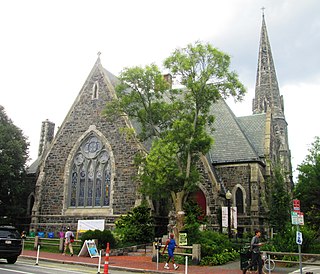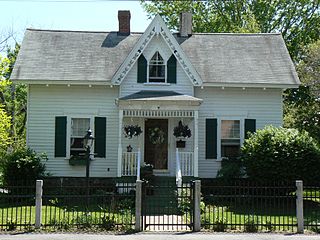
The Major Reuben Colburn House is a historic house museum and state historic site on Arnold Road in Pittston, Maine. Built in 1765, it was the home of Reuben Colburn, a patriot and shipbuilder, from 1765 to 1818. The house, one of the first to be built in the area, is most notable as one of the staging area's for Benedict Arnold's 1775 Quebec expedition. It is operated by the state as the Colburn House State Historic Site, and was listed on the National Register of Historic Places in 2004.

The Old Ship Church is a Puritan church built in 1681 in Hingham, Massachusetts. It is the only surviving 17th-century Puritan meetinghouse in the United States. Its congregation, gathered in 1635 and officially known as First Parish in Hingham, occupies the oldest church building in continuous ecclesiastical use in the country. On October 9, 1960, it was designated a National Historic Landmark, and on November 15, 1966, it was added to the National Register of Historic Places.

The First Unitarian Universalist Society in Newton occupies a prominent location at 1326 Washington Street in the heart of the village of West Newton in Newton, Massachusetts. Architect Ralph Adams Cram designed the church, Frederick Law Olmsted Jr. designed the grounds, the cornerstone was laid in 1905, and it was dedicated in 1906; it is one of the village's oldest buildings. The church is in Cram's signature Gothic Revival style, with buttressed walls and a blocky square tower with crenellations and spires. An enclosed courtyard is formed by an office wing, banquet hall, and parish house, which are built to resemble Elizabethan architecture with brick first floor and half-timbered upper level.

The Colburn School–High Street Historic District is a linear historic district encompassing the village center of Westwood, Massachusetts. It extends along High Street roughly between Conant Street in the north and Gay Street in the south. It is largely residential in character, with 37 houses, most of which date from the 18th to the mid-19th centuries. The rural character of the area is captured by a number of preserved 19th-century barns. The district also includes Westwood Town Hall, a 1910 Classical Revival building, and the 1874 Second Empire Colburn School. The school was named for Warren and Dana P. Colburn who both attended the school. They authored a book on arithmetic. Prior to being named for them in March 1867, it was known as the Clapboardtrees School, the West Dedham School and District Number Eight.

The Ephraim Atwood House is an historic house at 110 Hancock Street in Cambridge, Massachusetts. Built in 1839, it is a significant local example of transitional Greek Revival/Gothic Revival architecture, and one of the earliest houses built after the subdivision of Dana Hill. It was listed on the National Register of Historic Places on June 30, 1983.

The First Baptist Church is a historic American Baptist church at Magazine and River Street in Cambridge, Massachusetts within Central Square. In 1817 the church congregation was founded in the home of James Hovey. In 1844 several members of First Baptist Church left to found nearby Old Cambridge Baptist Church. First Baptist Church's current Gothic building was constructed in 1881 to a design by Hartwell and Richardson. It was added to the National Register of Historic Places in 1975.

The Old Cambridge Baptist Church is a historic American Baptist church at 400 Harvard Street in Cambridge, Massachusetts.

The Robert Frost House is an historic house in Cambridge, Massachusetts. It consists of four wood-frame townhouses, 2+1⁄2 stories in height, arranged in mirror image styling. Each pair of units has a porch providing access to those units, supported by turned posts and with a low Stick style balustrade. The Queen Anne/Stick style frame house was built in 1884, and has gables decorated with a modest amount of Gothic-style bargeboard. The house was home to poet Robert Frost for the last two decades of his life.

The Building at 104–106 Hancock Street is an historic cottage in Cambridge, Massachusetts. Built in 1839, it is a significant local example of transitional Greek Revival/Gothic Revival architecture, and one of the earliest houses built after the subdivision of Dana Hill. It was listed on the National Register of Historic Places in 1983.

The Anna Day House is an historic house in Cambridge, Massachusetts.

The Unitarian Universalist Church of Medford and The Osgood House are a historic Unitarian Universalist church building and parsonage house at 141 and 147 High Street in Medford, Massachusetts.

322 Haven Street in Reading, Massachusetts is well preserved cottage with Gothic and Italianate features. Built sometime before 1889, its use of even modest Gothic features is unusual in Reading, where the Gothic Revival was not particularly popular. The house was listed on the National Register of Historic Places in 1984.

The Stephen Hall House is a historic house at 64 Minot Street in Reading, Massachusetts. The 1+1⁄2-story wood-frame house was built in the 1850s, and is one of Reading's best examples of Gothic Victorian residential architecture. It has board-and-batten siding, long and narrow windows, and a central projecting gabled overhang with Gothic arched windows and a deep eave with brackets. Although it appears to be a near copy of a design published by Andrew Jackson Downing, its plan was apparently copied from a house in Wakefield, and is lacking some of Downing's proportions.

The Wendell Bancroft House is a historic house in Reading, Massachusetts. Built in the late 1860s, it is one of the town's few surviving examples of residential Gothic Revival architecture, built for one of its leading businessmen of the period. The house was listed on the National Register of Historic Places in 1984.

The Colburn School is a historic former school building at 136 Lawrence Street in Lowell, Massachusetts, USA. Built in 1848, it is a fine example of institutional Greek Revival architecture, and is one of the city's older surviving school buildings, built during the rapid population growth that followed the city's industrialization. Now converted to apartments, it was listed on the National Register of Historic Places in 1995.

The First Unitarian Church is a historic former church building in Stoneham, Massachusetts. One of Stoneham's more stylish Gothic Revival buildings, the Stick style wood structure was built in 1869 for a Unitarian congregation that was organized in 1858. The building was listed on the National Register of Historic Places in 1984, and included in the Central Square Historic District in 1990. It presently houses the local Community Access Television organization.

The House at 114 Marble Street in Stoneham, Massachusetts is a well-preserved Gothic Victorian cottage, built c. 1850. It is a 1+1⁄2-story wood-frame house with a rear ell, sheathed in wooden clapboards. It has a front gable centered over the main entry, which features turned posts and balusters, and a Stick-style valance. Windows in the gable ends have pointed arches characteristic of the style. The front gable is decorated with vergeboard.

The Gilbert Colburn House is a historic house at 110–112 Crescent Street in Waltham, Massachusetts. The two-story wood-frame duplex was built c. 1870, and is a nearly intact example of an Italianate house built for Waltham Watch Company workers. The main facade is symmetrical, with a pair of entrances at the center, each with its own ornate scrolled hood. They are flanked by a pair of two-story projecting polygonal bays with apron panels.

The House at 22 Parker Road is one of a few high style Colonial Revival houses in Wakefield, Massachusetts. The 2+1⁄2-story wood-frame house is estimated to have been built in the 1880s. It has a hip roof, corner pilasters, and gable end dormers, the center one having a swan-neck design. The main facade is divided into three sections: the leftmost has a rounded bay with three windows on each level, and the right section has a Palladian window configuration on the first floor, and a pair of windows on the second. The central section has the front door, sheltered by a porch that wraps around to the right side, flanked by sidelights and topped by a fanlight. Above the front door is a porch door flanked by wide windows and topped by a half-round window with Gothic style insets.

The Old Pittston Congregational Church is a historic church building on Pittston School Street in Pittston, Maine. Built in 1836, it is an architecturally distinctive blend of Federal, Greek Revival, and Gothic Revival architecture, and was listed on the National Register of Historic Places in 1978. The congregation, organized in 1812 by Major Reuben Colburn, now meets at 21 Arnold Road. It is affiliated with the Conservative Congregational Christian Conference.























